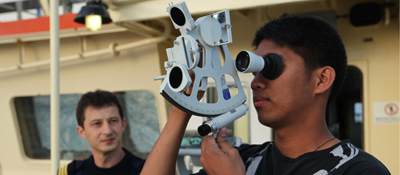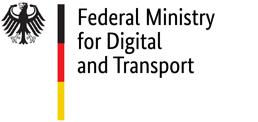Buschhöhe 8
28357 Bremen
www.machmeer.de
Phone: +49 421 17367-0
Fax: +49 421 17367-15
Mail: info@berufsbildung-see.de
Verband Deutscher Reeder
Burchardstr. 24
20095 Hamburg
Phone: +49 40 350970
Fax: +49 40 35097211
Mail: vdr@reederverband.de
Training courses
- Various ways to reach the goal
- Requirements for employment on board
- Career changers (engineering/ship's electro-technical engineering)
- Professional development
- Further sources of information
Various ways to reach the goal
The basic prerequisite for a training course in maritime shipping is always fitness for sea service. In addition, practical training and seagoing service are required in most cases.
- Training as a ship's mechanic is monitored by the Berufsbildungsstelle Seeschifffahrt e.V. (BBS) and leads to a state-recognized vocational qualification. It may also replace practical training and seagoing service as required by universities or technical colleges and as a prerequisite for certificates of competency and proficiency. The practical part of the training may only be carried out on certain ships.
- The practical training and seagoing service as a navigational officer's assistant (NOA), technical officer's assistant (TOA), electro-technical officer's assistant (ETOA) or ship's operation technical assistant (Schiffsbetriebstechnischer Assistant - SBTA) is a unique part of the training. It can be completed on merchant ships under all flags and must generally be completed by the time of the vocational aptitude test. It can also be recognized by universities or technical colleges or for certificates of competency or proficiency as practical training and seagoing service. However, it is not a state-recognized vocational qualification!
- Maritime universities or technical colleges offer training to become an officer in the field of nautical science, engineering or ship's electro-technical engineering. Depending on the level of graduation from secondary school, the training programme at schools varies greatly; practical training and seagoing service is always a part of it.
Directly after graduation, the first step is to enter the operational level on the ship. Once the required seagoing service has been completed, navigational and engineer officers are able to advance to a higher position on board (management level). - Training as an officer (for engineering or electro-technical engineering) is also possible for so-called "career changers" with a completed apprenticeship in metalwork or electro-technical engineering, if the training meets the requirements of the Seafarers' Competencies and Proficiencies Regulations (See-BV).
Requirements for service on board
After completion of any of the various training courses, the relevant certificates of competency and proficiency from the Federal Maritime and Hydrographic Agency (BSH) are required for service on board. They are issued upon application, correspond to the designation in the STCW Convention, but do not match the designations of the degrees at the schools.
After vocational graduation, ship's mechanics may begin work on board a ship as able seafarer deck and able seafarer engine at the support level.
Directly after graduation from a university or technical college, entry into the operational level on the ship occurs generally as a watchkeeping officer (navigational/engineering) or electro-technical officer.
After further seagoing service on merchant ships in a responsible position, advancement to the management level is possible: as chief mate, second engineer officer, master or chief engineer officer.
Career changers (engineering/ship's electro-technical engineering)
For marine engineering or electro-technical service, there are opportunities for career changers whose regulated professions are in or who have proficiency in electrical manufacturing and metalworking. These professions or proficiencies must each meet minimum requirements as stated in the Seafarers' Competencies and Proficiencies Regulations (See-BV, please see German version for latest amendment status) and the "Richtlinien für die praktische Ausbildung und Seefahrtzeit" (guidelines for practical training and seagoing service).
Career changers (engineering): proficiency in metalworking
Career changers can attain the positions of engineering watchkeeping officer (TWO), engine operator (TSM) or engine-room watch proficiency (TWB) in marine engineering service and later also advance to the position of second engineer officer (TZO) or chief engineer officer (TLM). For entry to TWO, TSM or TWB, you must always prove proficiency in metalworking (see Annex 6 See-BV). You have the following options for this proof
You have completed a regulated course of training in the fields of metalwork or electrical engineering that meets the requirements of the Seafarers' Competencies and Proficiencies Regulations. Since these professions include proficiency in metalwork, you can use such a qualification to reduce the required seagoing service accordingly (in accordance with Annex 1c of the Richtlinien für die Ausbildung von technischen Offiziersassistenten / Offiziersassistentinnen in der Seeschifffahrt, in German only).
Or you can prove proficiency in metalwork with one of the following certificates:
for the TWO
for the TSM und TWB
Inter-company training courses in metalworking
The courses recognized by the Berufsbildungsstelle Seeschifffahrt e.V. (mentioned under point 3.) can be completed at the following vocational schools. Addresses and contact details can be found via the respective link (in German only).
- AFZ Aus- und Fortbildungszentrum Rostock GmbH
- Schleswig Holsteinische Seemannsschule
- Maritimes Kompetenzzentrum Elsfleth gGmbH
Career changers in marine electrical engineering: proficiency in electrical manufacturing and metalworking
Career changers can attain the position of electro-technical officer (ETO) in the marine engineering service; to do so, they must always prove proficiency in electrical manufacturing and metalworking. You have the following options for this proof.
You have completed a regulated profession in electrical engineering (in German only), a recognized degree from a vocational school or a technical college or university degree in electrical engineering, and these training courses meet the requirements of the Seafarers' Competencies and Proficiencies Regulations. Since these training courses also include proficiency of electrical manufacturing and metalworking (see Annex 6a See-BV), you can use these qualifications to reduce the required seagoing service accordingly (in accordance with Annex 1c of the Richtlinien für die Ausbildung von elektrotechnischen Offiziersassistenten / Offiziersassistentinnen in der Seeschifffahrt, in German only).
Or, if you do not have any of the above-mentioned training, you can alternatively take courses in electrical manufacturing and metalworking. In this case, however, you will not be able to shorten your seagoing service.
Click here for more information on changing your career (in German only).

Professional development
In accordance with the STCW Convention and in conjunction with the ISM Code, continuous training for certain functions on board is required of all seafarers. Some professional development is a prerequisite for the issuance and validity extension of certificates of competency and proficiency. This professional development takes place in approved courses, which must be approved either by the BSH or the Ship Safety Division or BG Verkehr, respectively.
Further sources of information
- Further information on vocational schools, technical colleges and universities as well as course providers can be found on this website under Training Facilities.
- If you have any questions about certificates of competency or certificates of proficiency, please contact the BSH; you will find them under Further contact options.
- Information specifically for young people and shipping companies can be found on the website on maritime training www.machmeer.de (in German only).
- The Berufsbildungsstelle Seeschifffahrt e.V. and the Zentrale Heuerstelle Hamburg (in German only) will also be happy to provide advice on maritime training and professions (partly also on training in coastal shipping or fishing).
- Likewise, the German Shipowners' Association provides information on careers in shipping.

